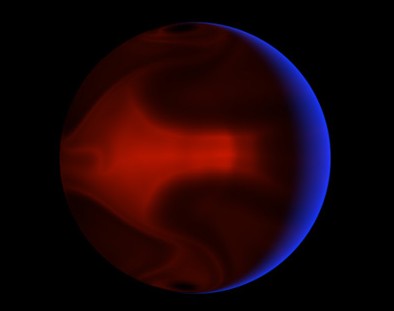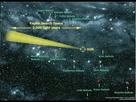Heat Wave on Exoplanet
700 degrees in 6 hours
The planet HD 80606b is everything except a friend to life: The orbit is extremely elliptic and leads the planet closer to its star, even closer then mercury gets to the sun. Within only 111 days the distance between the planet and the star varies from 81 Million miles to as little as 3 Million. American astronomers measured temperature changes with the help of space telescope Spitzer. According to the scientists’ article in the magazine “Nature” in the stage when the planet gets closest to the star an enormous heat wave is triggered in the atmosphere of the planet.
 © UCSC |
The planet HD80606b glows because of the enormous heat (computer animated picture)
Laughlin and his colleagues observed the planet HD 80606b, which has four times the mass of Jupiter, with the infrared telescope Spitzer for a total of 30 hours. In this time frame the planet was closest to the star. Something unexpected helped the scientists out as well. Just before the planet reached the point where it is closest to the star it just disappeared for a short while – a secondary eclipse. The orbital plane was unknown, but the coincidence allowed the scientists to separate the planet’s and the star’s radiation.
The data suggests that the planet’s atmosphere got heated from 800 to 1500 Kelvin in only six hours. In the scientists’ opinion the fast heating points to the explanation that the radiation of the star is absorbed in a high layer of the atmosphere. Model calculations show that the heat wave leads to global storms on the planet. The astronomers assume that HD 80606b moves across the star from our perspective. Professional and hobby astronomers alike prepare to observe that primary eclipse in hopes of new conclusive data.
Rainaer Kayser, Phd is a journalist in Hamburg, Germany
Heat Wave on Exoplanet
700 degrees in 6 hours
The planet HD 80606b is everything except a friend to life: The orbit is extremely elliptic and leads the planet closer to its star, even closer then mercury gets to the sun. Within only 111 days the distance between the planet and the star varies from 81 Million miles to as little as 3 Million. American astronomers measured temperature changes with the help of space telescope Spitzer. According to the scientists’ article in the magazine “Nature” in the stage when the planet gets closest to the star an enormous heat wave is triggered in the atmosphere of the planet.
 © UCSC |
The planet HD80606b glows because of the enormous heat (computer animated picture)
Laughlin and his colleagues observed the planet HD 80606b, which has four times the mass of Jupiter, with the infrared telescope Spitzer for a total of 30 hours. In this time frame the planet was closest to the star. Something unexpected helped the scientists out as well. Just before the planet reached the point where it is closest to the star it just disappeared for a short while – a secondary eclipse. The orbital plane was unknown, but the coincidence allowed the scientists to separate the planet’s and the star’s radiation.
The data suggests that the planet’s atmosphere got heated from 800 to 1500 Kelvin in only six hours. In the scientists’ opinion the fast heating points to the explanation that the radiation of the star is absorbed in a high layer of the atmosphere. Model calculations show that the heat wave leads to global storms on the planet. The astronomers assume that HD 80606b moves across the star from our perspective. Professional and hobby astronomers alike prepare to observe that primary eclipse in hopes of new conclusive data.
Rainaer Kayser, Phd is a journalist in Hamburg, Germany








